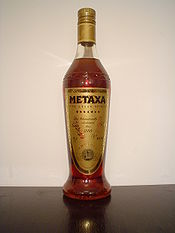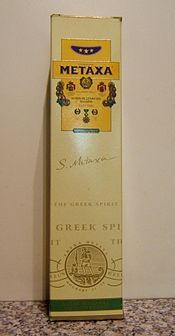- Metaxa
-
Metaxa (Greek: Μεταξά) is a Greek distilled spirit invented by Spyros Metaxas in 1888. It is a blend of brandy and wine made from sun-dried Savatiano, Sultana and Black Corinth grape varieties. It is then blended with an aged Muscat wine from the Greek islands of Samos and Lemnos. It is exported to over 60 countries.[citation needed]
Contents
Production
The first production of the distillates begins with the distillation of various wine varieties (mainly Savatiano and Rhoditis) that after a double distillation are kept in cellars in relatively small, brand new, oak, of the limousine type barrels of 300–350 L usually made in France. French barrels are considered more desirable than those made in America due to the fact that the species of French Oak used in barrel production have smaller pores than its American counterpart. These small pores slow down the transfer of flavor between the barrel and the liquor contained within it, resulting in a more subtle, refined finished product. Some of the distillates are moved in large barrels of 3 cubic meter volume to mature further and used for the main body of the blend. It will mature anywhere from three (the three star Metaxa) to 30 years for the Grand Reserve.
The mean time wine is being prepared for the Alexandrian and Samian Moschatto from the area of Samos, Limnos and Patras. The wine is maturing for nearly two years in used metaxa barrels. It turns to a deep caramel color with very rich aromas, from the moschatto with dominant the aromas of dried fruits, lavender, white roses and hints of various spices. Its flavour is rich and sweet.
The third part of the process is the most top guarded secret of the company and only a few people know the process and the precise recipe. A mixture of various spices and distilled water is prepared. To the base, the rose petals, spices and other herbal flavourings are added. The final product has a very complex and unique aromatic character that has aromas of roses, pepper, bay leaf, cinnamon and nutmeg. This mixture is allowed to "marry" for at least six months, then chilled at -6°C for 48 hours,[1] filtered, before being bottled.
Those three blends are mixed at the final blending in such a way that the quality, taste, colour and aromas of the brandy are kept as constant as possible. Final steps involve the correction of the colour and the balancing of the alcohol levels. Most of them are mixed with young Moschatto wine to mellow the flavour.
Types of Metaxa
Metaxa comes in five major varieties: Three Stars, Five Stars, Seven Stars, Twelve Stars and the Grand Reserve. The number of stars represents the number of years the blend is matured. The three and 5 star are not as different, but the 5 star is notably drier, making the alcohol more pronounced. The seven and twelve star are more flavoursome and complex, while the twelve is again more dry, in this case because there is no addition of wine. In either of the two latter varieties, the smell and taste of the barrel in which the brandy matured is noticeable. The Grand Reserve is the most expensive and difficult to find.
The Twelve-Star version is now distributed internationally. Additional varieties and collectors' items, such as the Grand Olympian Reserve Celebration Edition, are available only in some regions.
Metaxa is traditionally served neat, on the rocks, or mixed (usually with sours).
History of Metaxa
The founder of the distillery was Spyros Metaxas, born in the island of Kefalonia. He created the first brandy and was involved in the foundation of the first distillation facility in 1888, a little over 50 years after the Greek War of Independence. The business was soon expanded with new factories in Constantinople and Odessa. In 1900 the first exports to the United States took place and the drink became known as "the flying brandy". Following Metaxas' death, his sons carried on his work. Metaxa is the only Greek industry that survived the two World Wars. In 1968 the factory was rebuilt and, although it consists of state-of-the-art equipment, its output tastes the same as from the traditional method.
The label shows a Salaminomaho (Salamina fighter), a figure of an Ancient Greek trireme that was carved on a coin of that period, found during the excavation of the first factory in 1888.[citation needed]
Metaxa won over the toughest critics and has earned a respected position in the pantheon of fine spirits. In 1989 the company was bought by the British drinks group Grand Metropolitan (now re branded as Diageo) and was later sold to the Remy Cointreau group.[2]
See also
References
External links
- The official Facebook page for Metaxa
- The official Facebook page for Metaxa USA
- The official homepage
- Article in Greek news paper about the history of Metaxa
- History and production of Metaxa
Categories:- Distilled beverages
- Greek distilled beverages
- Herbal liqueurs
Wikimedia Foundation. 2010.





